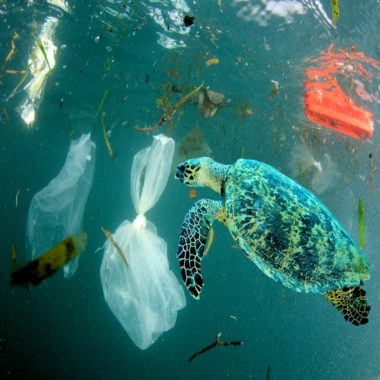The amount of plastic in the ocean is one of the most significant challenges facing fragile ecosystems around the world. At least eight million tons of plastic end up in our oceans every year with the total amount already estimated at 150 million tons.
To put this number in perspective, this is the equivalent weight of 480,000 double-decker buses going into the ocean each year. On a personal level, with the amount of plastic marine life are currently ingesting, if you eat fish, you also consume 11,000 pieces of plastic a year.
With 2020 being another crucial year for governments across the world legislating for bans of single-use plastics, the severity of the problem has gained international recognition. For example, as of July 2019, the United Nations counted 127 nations that have banned or taxed plastic bags. And with a change at national government level, our attitudes towards plastic consumption have also altered. More of us are now using reusable coffee cups and water bottles, for instance, as well as calling out companies that use large amounts of unnecessary plastic.
What can the financial services industry do?
The banking and financial services industry also has a key part to play in this drive towards a more sustainable economy. Every year, the amount of plastic used to produce banking cards is equivalent to the weight of about 150 Boeing 747 air planes. It is time for the industry to think about plausible solutions to reduce PVC consumption, while still making sure they are renewing their customers’ payment cards for security measures.
How about using recycled material?
There are two types of commonly referenced recycled material: Pre- and post-consumer. Pre-consumer recycled material refers to the recycling of industrial waste that never actually made it to the consumer, such as scraps, discards, and trimmings. The problem is, sometimes it’s not truly regarded as recycled material, given that manufactures have been long driven by cost-saving reasons to repurpose their waste, which they are already doing.
On the other hand, let’s talk about post-consumer recycled material. This refers to the waste that’s been used and disposed of by a consumer. As one can imagine, recycling this waste is much more difficult than their pre-consumer cousins. It is, however, considered to have more sustainable benefit as it’s more likely to end up in a landfill if not being recycled. This is where Thales is focusing – a solution that helps our environment using post-consumer recycled plastic to protect our oceans.
Post-consumer material recycling in action
In September 2019, Thales partnered with a leading payment card issuer to announce the introduction of the first-ever bank card made with 70% reclaimed plastic collected from beaches, islands and coastal communities. Each new card will be made from approximately one plastic bottle and is a great symbol of change for card members, merchants and partners, looking for a leading example.
Why this makes business sense
According to a recent study by Accenture and U.N. Global Compact CEO, 94% of CEOs believe that making environmental efforts are important to the future success of their business – clearly the drive towards making more eco-friendly changes is not going anywhere and should, therefore, be embraced by more and more banks in the coming years.
An eco-friendlier business model has proven to be extremely successful in other markets. In the clothing industry, for example, huge brand names like Adidas and Patagonia earning huge profits, while also embedding environmental responsibility into their ethos. Adidas, for example have consistently seen sales of their recycled plastic shoes rise with one million pairs of shoes produced in 2017, five million in 2018, and 11 million in 2019. It is clear there is a growing recognition of the interdependencies between business and social wellbeing.
There’s nothing preventing us doing the same in the payment industry. The card made with ocean plastic passed the same qualification process as standard PVC card. Meaning it has the same level of durability and brings cardholders even better user experience: As durable, but more eco-friendly!
In terms of cost, the cardholder is not buying the card, but rather subscribing to a payment service. Therefore, issuers’ service fees are not directly related to the card body itself. While some issuers may charge more for an eco-friendly payment service, we will not see one single pricing approach among all issuers worldwide.
What trends are we seeing from consumers?
Evidently from the above, companies with strong environmental values are striking a chord with millions of consumers around the world. The success of this business model proves that private enterprises like banks can put the dignity of our planet at their core without fearing they will lose customers.
For consumers, supporting companies who are protecting the planet is an easy way to help the environment. Changes like opting for a bank card made from ocean plastic may seem small, but it helps customers to feel good knowing that they have contributed to supporting the wider ecosystem, while not having to overhaul their lifestyles.
Additionally, more consumers than ever before are concerned with sustainability. A 2019 survey led by Hotwire found that 47% of internet users worldwide had ditched products and services from a brand that violated their personal values. Protecting the environment topped that list. Therefore, ultimately, if banks want to keep customers, core environmental values are not only a nice thing to have but may also be a necessity to keep their customer base.
It is fascinating to witness a transformation towards an eco-friendlier future as new things like plastic pollution begin to have value for businesses. In the financial services industry, there are numerous advantages for banks who are willing to take the plunge with a business model that takes environmental issues into consideration, both from a production and consumer point of view. The time has come for environmental corporate social responsibility to become the new norm for all banks and we are available to help with the journey for those who want to undergo it.
To find out how you can be part of this sea change, visit our website here.



